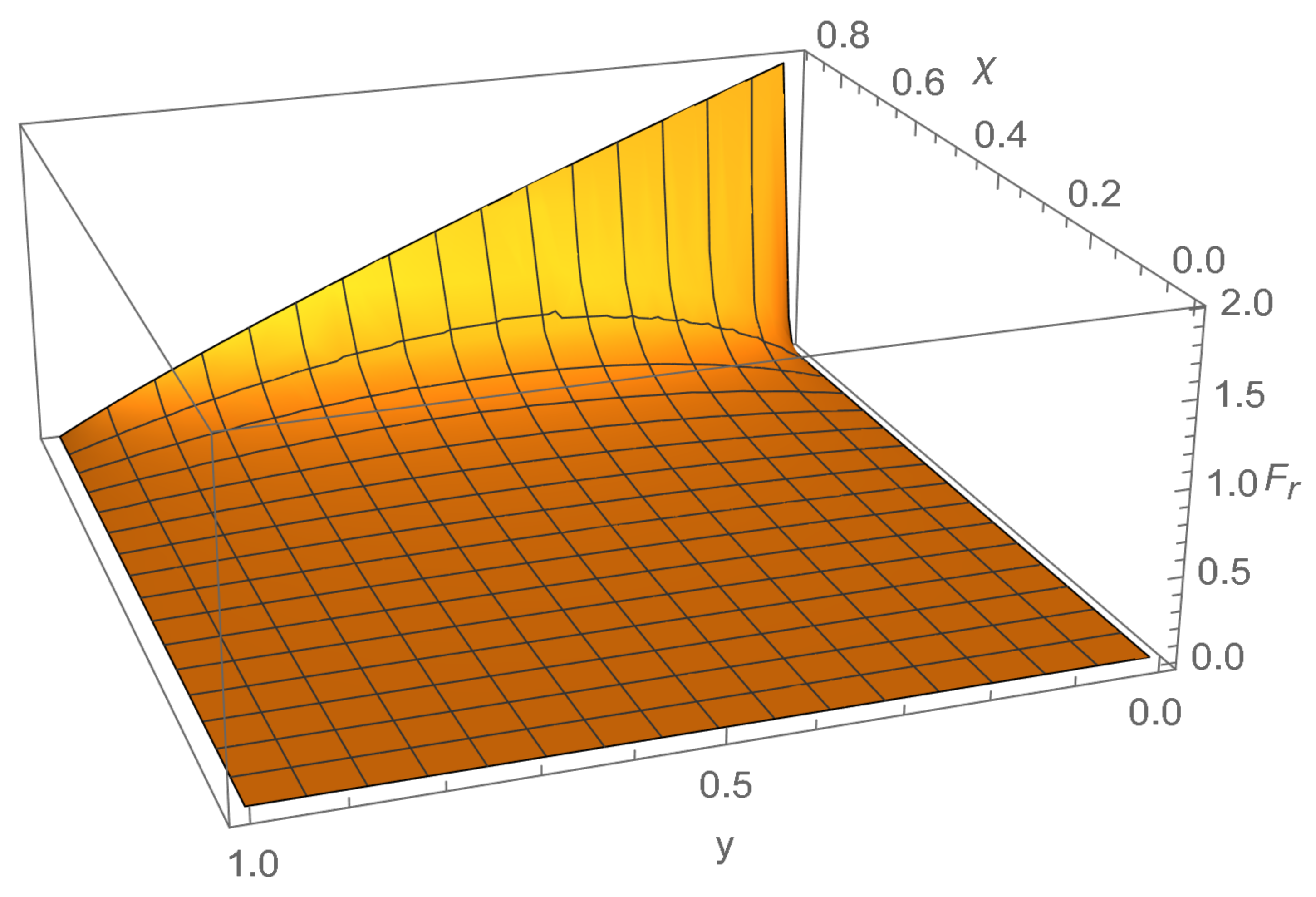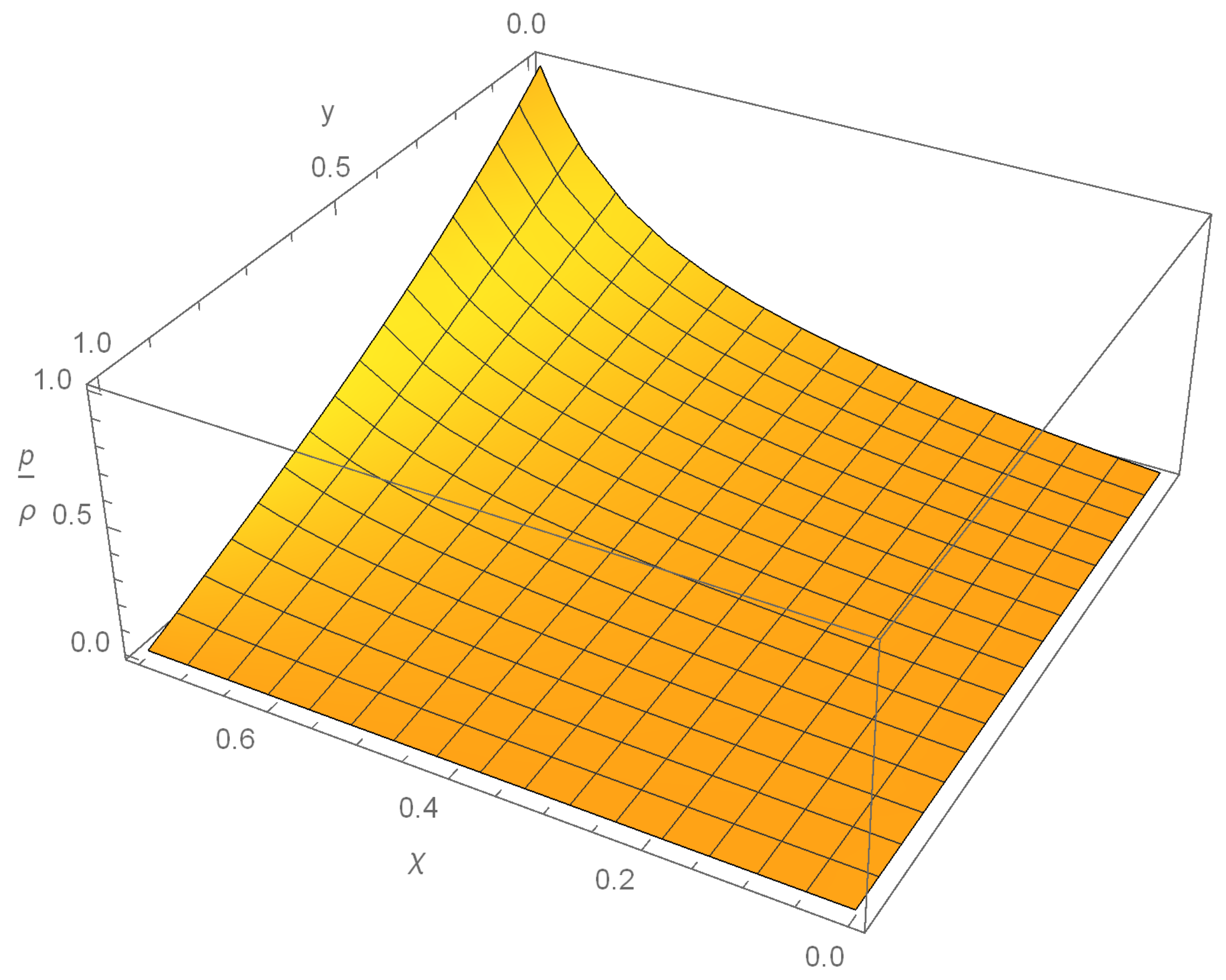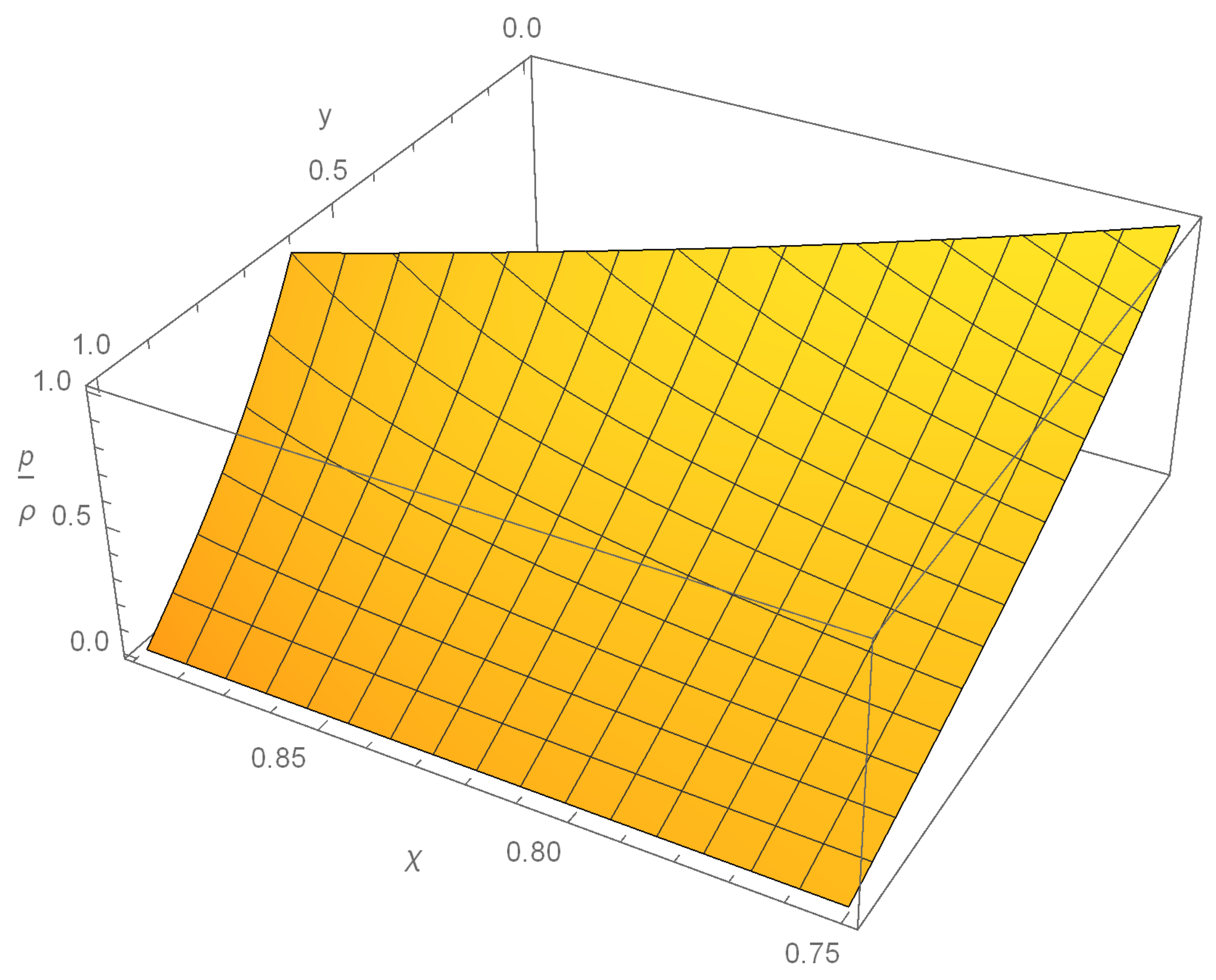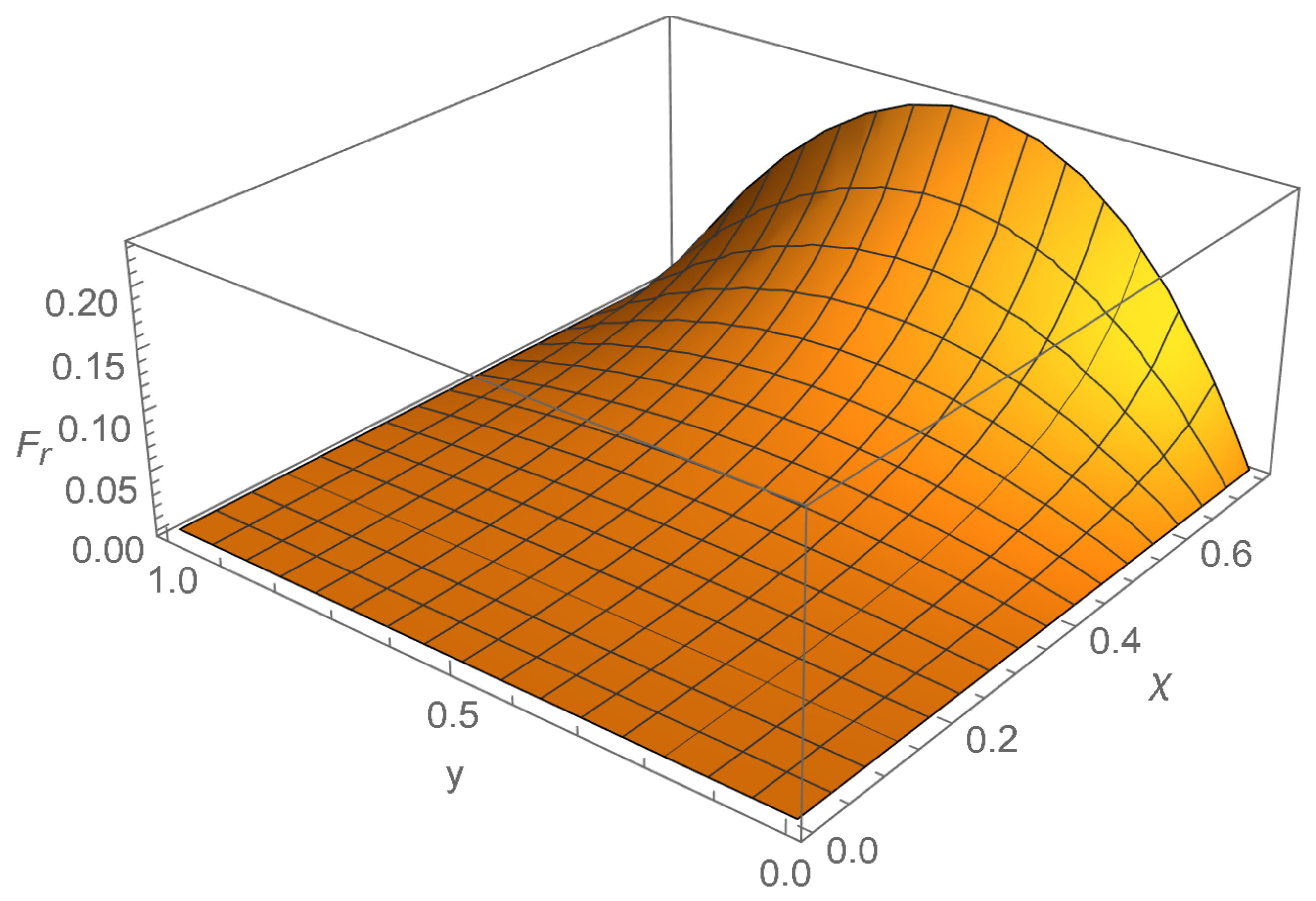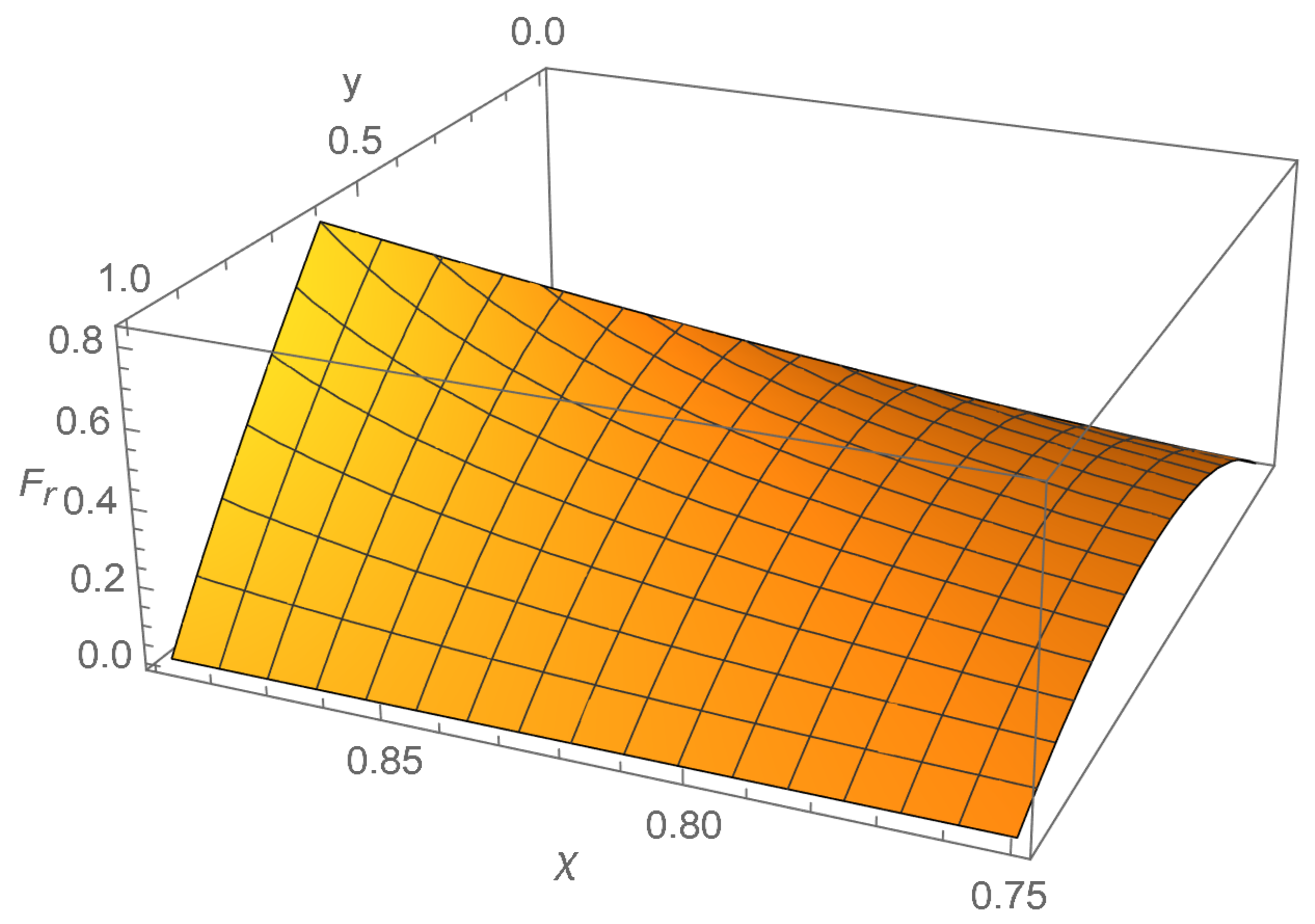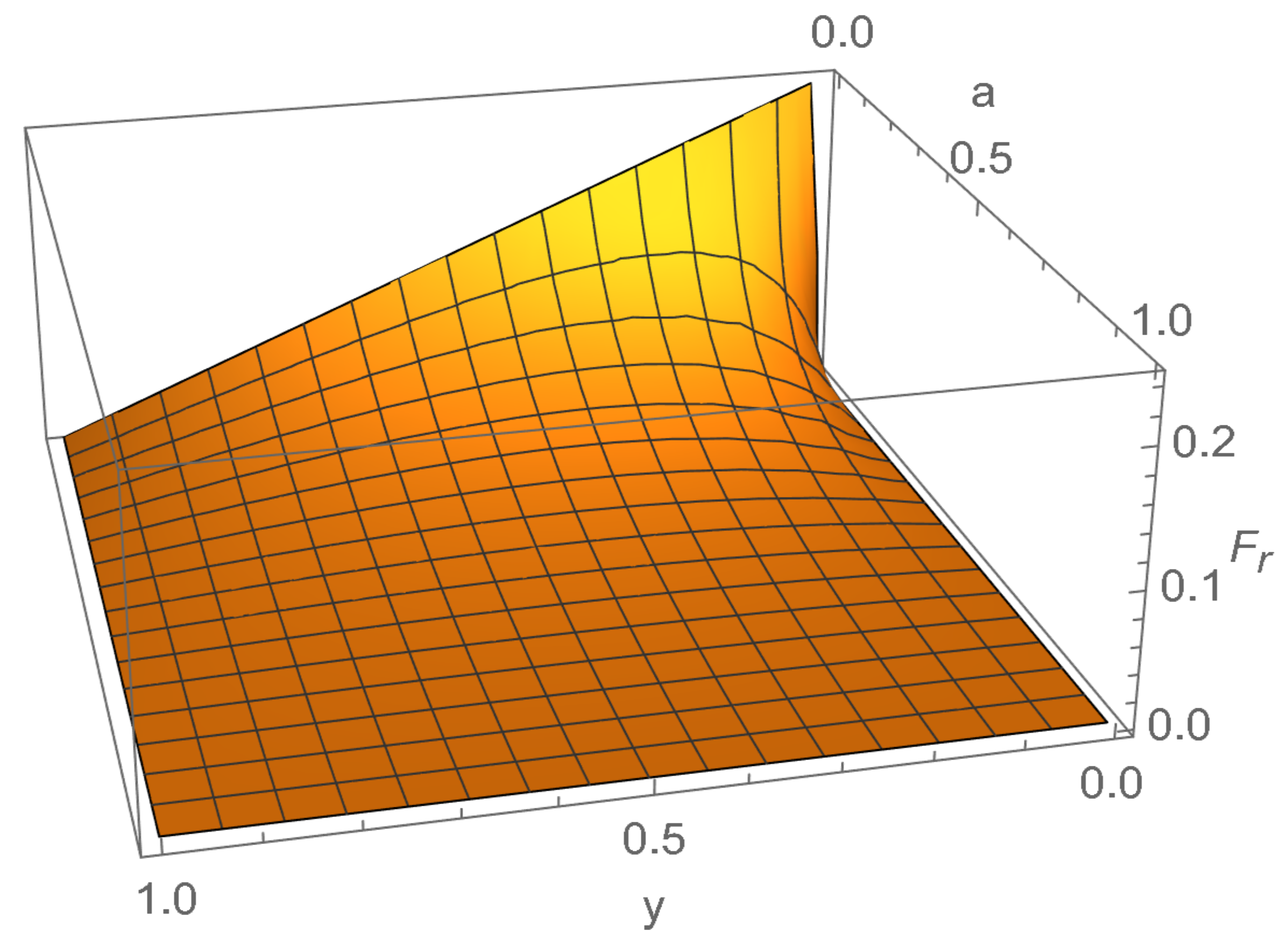3.1. Generalities
The perfect fluid condition excludes pressure anisotropy so that the radial and transverse pressures are set equal:
. Once this is done, the radial and hemispherical forces simplify
Additionally, we shall impose the conditions that pressure is positive and decreases as one moves outwards with zero pressure defining the surface of the object [
10,
11,
12,
13,
14,
15,
16,
17,
18]. (There is a minor technical change in the presence of a cosmological constant, the surface is then defined by
). Similarly, density is positive and does not increase as one moves outwards, though density need not be and typically is not zero at the surface [
10,
11,
12,
13,
14,
15,
16,
17,
18].
We note that for the radial force we have by construction
In particular, in terms of the central pressure
we have the particularly simple bound
This suggests that in general an (extremely) weak version of the maximum force conjecture might hold for the radial force, at least within the framework outlined above, and as long as the central pressure is finite. Unfortunately without some general relationship between central pressure and radius this bound is less useful than one might hope. For the strong version of the maximum force conjecture no such simple argument holds for , and one must perform a case-by-case analysis. For the hemispherical force there is no similar argument of comparable generality, and one must again perform a case-by-case analysis.
Turning now to the classical energy conditions [
19,
20,
21,
22,
23,
24,
25,
26,
27,
28], they add extra restrictions to ensure that various physical properties remain well-behaved. For our perfect fluid solutions, these act as statements relating the pressure
p and the density
given by the stress–energy tensor
. Since (in view of our fundamental assumptions that pressure and density are both positive) the null, weak, and strong energy conditions (NEC, WEC, SEC) are always automatically satisfied, we will
only be interested in the dominant energy condition (DEC). In the current context the dominant energy condition only adds the condition
. However, since in the context of perfect fluid spheres, the pressure is always positive, it is more convenient to simply write this as
The best physical interpretation of the DEC is that it guarantees that any timelike observer with 4-velocity
will observe a flux
that is non-spacelike (either timelike or null) [
25]. However, it should be pointed out that the DEC, being the strongest of the classical energy conditions, is also the easiest to violate—indeed there are several known situations in which the classical DEC is violated by quantum effects [
20,
21,
22,
23,
24,
25,
26,
27,
28].
The DEC is sometimes (somewhat misleadingly) interpreted in terms of the speed of sound not being superluminal: naively
; whence
. However, the implication is only one-way, and in addition the argument depends on extra technical assumptions to the effect that the fluid sphere is well-mixed with a unique barotropic equation of state
holding throughout the interior. To clarify this point, suppose the equation of state is not barotropic, so that
, with the
being some collection of intensive variables (possibly chemical concentrations, entropy density, or temperature). Then we have
Then, noting that
is non-positive as one moves outwards, enforcing the speed of sound to not be superluminal implies
Integrating this from the surface inwards we have
Consequently, unless one either makes an explicit barotropic assumption
, or otherwise at the very least has some very tight control over the partial derivatives
, one simply cannot use an assumed non-superluminal speed of sound to deduce the DEC. Neither can the DEC be used to derive a non-superluminal speed of sound, at least not without many extra and powerful technical assumptions. We have been rather explicit with this discussion since we have seen considerable confusion on this point. Finally, we note that there is some disagreement as to whether or not the DEC is truly fundamental [
21,
22,
23,
24].
3.2. Schwarzschild’s Constant Density Star
We shall now consider a classic example of perfect fluid star, Schwarzschild’s constant density star [
29] (often called the Schwarzschild interior solution), which was discovered very shortly after Schwarzschild’s original vacuum solution [
30] (often called the Schwarzschild exterior solution).
It is commonly argued that Schwarzschild’s constant density star is “unphysical” on the grounds that it allegedly leads to an infinite speed of sound. However, this is a naive result predicated on the physically unreasonable hypothesis that the star is well-mixed with a barotropic equation of state
. To be very explicit about this, all realistic stars are physically stratified with non-barotropic equations of state
, with the
being some collection of intensive variables (possibly chemical concentrations, entropy density, or temperature). We have already seen that
Thence, for a constant density star,
, we simply deduce
This tells us nothing about the speed of sound, one way or the other—it does tell us that there is a fine-tuning between the pressure p and the intensive variables , but that is implied by the definition of being a “constant density star”. We have again been rather explicit with this discussion since we have seen considerable confusion on this point. Schwarzschild’s constant density star is not “unphysical”; it may be “fine-tuned” but it is not a priori “unphysical”.
Specifically, the Schwarzschild interior solution describes the geometry inside a static spherically symmetric perfect fluid constant density star with radius
and mass
M by the metric:
Here we have adopted geometrodynamic units (
,
). Calculating the non-zero orthonormal stress–energy components from the Einstein equations applied to this metric yields:
This gives us the relation between density and pressure, as well as demonstrating the perfect fluid condition (
), and also verifying that the density is (inside the star) a position-independent constant. In these geometrodynamic units both density and pressure have units 1/(length)
, while forces are dimensionless. Note that the pressure does in fact go to zero at
, so
really is the surface of the “star”. Rewriting the relation between pressure and density in terms of the simplified dimensionless quantities
and
we see
Here,
and
. The first of these ranges is obvious from the definition of
y, while the second comes from considering the central pressure at
:
Demanding that the central pressure be finite requires
. (This is actually a rather more general result of general relativistic stellar dynamics, not restricted to constant density; see various discussions of the Buchdahl–Bondi bound [
31,
32]).
3.2.1. Radial Force
The radial force
as defined by Equation (
8) can be combined with the pressure–density relation given by Equation (
21), giving:
As advertised in both the abstract and introduction, this quantity is indeed a dimensionless function of dimensionless variables. Furthermore, this quantity is defined on the bounded range , . To find if itself is bounded we analyze the multi-variable derivative for critical points.
In particular we see that
To have a critical point,
, we certainly require
. Therefore, either
or
. However, for
, and
we have
In contrast, for
, and
, we have
. Therefore the only critical points lie on one of the boundary segments:
Therefore to find the maxima of we must inspect all four of the boundary segments of the viable region. Along three of the boundary segments we can see that the three lines corresponding to , , and all give , leaving only to be investigated.
Inserting this into the partial derivative
reveals:
This is a strictly negative function in the range .
Thus the maximum of
can be found by taking the limit
giving:
This is therefore bounded, with the radial force approaching its maximum at the centre of a fluid star that is on the verge of collapse. This force violates the strong maximum force conjecture, though it satisfies the weak maximum force conjecture. This limit can easily be seen graphically in
Figure 1.
3.2.2. Hemspherical Force
Using Equation (
9) and the metric defined in Equation (
18), with the relabelling of the previous subsection in terms of
and
y gives:
The integral evaluates to:
However, due to the presence of the
term in this equation, it can be seen that as
,
. Indeed
implying that the hemispherical force in this space-time will grow without bound as the star approaches the critical size (just prior to gravitational collapse), in violation of both the strong and weak maximum force conjectures.
Therefore, while the interior Schwarzschild solution has provided a nice example of a bounded radial force, , it also clearly provides an explicit counter-example, where the hemispherical force between two hemispheres of the fluid star grows without bound.
3.2.3. DEC
Imposing the DEC (Equation (
12)) within the fluid sphere we would require:
Applying the boundary conditions of
,
, we have a solution range:
Within the first region
, the radial force is maximized at:
Under these conditions the strong maximum force conjecture is satisfied. This can be seen visually in
Figure 4.
Within the second region
, the radial force is maximized at:
Under these conditions the strong maximum force conjecture is violated, though the weak maximum force conjecture is satisfied. This can be seen visually in
Figure 5.
Turning to the hemispherical force, we see that the integrand used to define the integral for
satisfies the DEC only within the range
. Using the result for
given above, Equation (
34), we have:
This now satisfies the strong maximum force conjecture.
3.2.4. Summary (Schwarzschild Interior)
Only if we enforce the DEC can we then make Schwarzschild’s constant density star satisfy the weak and strong maximum force conjectures. Without adding the DEC Schwarzschild’s constant density star will violate both the weak and strong maximum force conjectures. Since it is not entirely clear that the DEC represents fundamental physics [
21,
22,
23,
24], it is perhaps a little sobering to see that one of the very simplest idealized stellar models already raises issues for the maximum force conjecture. We shall soon see that the situation is even worse for the Tolman IV model (and its variants).
3.3. Tolman IV Solution
The Tolman IV solution is another perfect fluid star space-time; however, it does not have the convenient (albeit fine-tuned) property of constant density like the interior Schwarzschild solution. The metric can be written in the traditional form [
10]:
Here
A and
R represent some arbitrary scale factors with units of length. This metric yields the orthonormal stress–energy tensor:
This demonstrates the non-constancy of the energy-density
, as well as the perfect fluid conditions. Physically, the surface of a fluid star is defined as the zero pressure point, which is now at:
Likewise, we can find the surface density (
at
):
The central pressure and central density are
Moving forwards, we will likewise calculate the radial and hemispherical forces in this space-time.
3.3.1. Radial Force
Using the previously defined radial force Equation (
6), we can write the radial force for the Tolman IV space-time as:
Defining
and
we have
and
. The radial force then simplifies to
Note this is, as expected, a dimensionless function of dimensionless variables.
The multivariable derivatives are:
For both derivatives to vanish (within the physical region), we require
. However
actually minimizes the function with
. Therefore, we need to look at the boundaries of the physical region. Both
and
also minimize the function with
. We thus consider
:
where then it is clear that the function is maximized at
,
, which corresponds to
. This can be seen visually in
Figure 6. Thus
for the Tolman IV solution is compatible with the strong maximum force conjecture, but as for the Schwarzschild constant density star, we shall soon see that the hemispherical force does not behave as nicely.
3.3.2. Hemispherical Force
Using Equation (
9) for this space-time, and combining it with the radial surface result of Equation (
46), we obtain:
As an integral this converges; however, the resultant function is intractable. Instead, we will opt for a simpler approach by finding a simple bound. Since the radial coordinate is physically bound by
, we find that in that range:
This is actually a much more general result; for any perfect fluid sphere we have
where
is the Misner–Sharp quasi-local mass.
So as long as
is positive, which is guaranteed by positivity of the density
, we have
, and so in all generality we have
For the specific case of Tolman IV we can write
Now make the substitutions
and
. We find
Under the limit
we find that the term
. Therefore, the inequality (
61) diverges to infinity, demonstrating that the hemispherical force in the Tolman-IV space-time can be made to violate the weak maximum force conjecture.
Thus, as in the case of the interior Schwarzschild solution, we have shown that the radial force is bounded (and in this case obeys both the weak and strong maximum force conjectures). However, the hemispherical force can be made to diverge to infinity and act as a counter-example to both weak and strong conjectures.
3.3.3. DEC
To see if the DEC is satisfied over the range of integration for the hemispherical force, we inquire as to whether or not
It is straightforward to check that this inequality will always hold in the physical region. Using the definitions
and
, so that
, and
, we can write this as
which is manifestly negative. Therefore, adding the DEC does not affect or change our conclusions. Indeed, we have already seen that the hemispherical force diverges in the limit of
implying
. Applying this limit to the ratio
gives:
Again, this is always true within any physical region, so we verify that adding the DEC does not change our conclusions.
3.3.4. Summary (Tolman IV)
For the Tolman IV solution, while the radial force is bounded (and obeys both the weak and strong maximum force conjectures), the hemispherical force can be made to diverge to infinity in certain parts of parameter space () and acts as a counter-example to both weak and strong maximum force conjectures. For the Tolman IV solution, adding the DEC does not save the situation; the violation of both weak and strong maximum force conjectures is robust.
3.4. Buchdahl–Land Spacetime:
The Buchdahl–Land spacetime [
33] is a special case of the Tolman IV spacetime, corresponding to the limit
(equivalently
). It is sufficiently simple that it is worth some discussion in its own right. The Tolman IV metric (with a re-scaled time coordinate
) can be written:
Under the limit
, this becomes [
33]:
Then the orthonormal stress–energy components are:
The surface is located at
At the centre the pressure and density both diverge—more on this point later.
This is simply a relabeling of Equation (
66). The orthonormal stress–energy tensor is now relabeled as:
That is, the Buchdahl–Land spacetime represents a “stiff fluid”. This perfect fluid solution has a naked singularity at and a well behaved surface at finite radius. The singularity at is not really a problem as one can always excise a small core region near to regularize the model.
3.4.1. Radial Force
Due to the simplicity of the pressure, the radial force can be easily calculated as:
The radial force is trivially bounded with a maximum of at the center of the star. This obeys the strong (and so also the weak) maximum force conjecture.
3.4.2. Hemispherical Force
The hemispherical force is:
This is now simple enough to handle analytically. Using the dimensionless variable
, with range
, we see:
This is manifestly dimensionless, and manifestly diverges to
. If we excise a small region
(corresponding to
) to regularize the model, replacing
with some well-behaved fluid ball, then we have the explicit logarithmic divergence
This violates the weak (and so also the strong) maximum force conjecture.
3.4.3. DEC
The DEC for this space-time is given by:
which is always true for positive values of
r,
.
3.4.4. Summary (Buchdahl–Land)
Thus we see that the Buchdahl–Land spacetime provides yet another counter-example to the weak maximum force conjecture, a counter-example that again obeys the classical energy conditions.
3.5. Scaling Solution
This produces the following stress–energy tensor:
This perfect fluid solution has a naked singularity at
and does not have a finite surface—it requires
for the pressure to vanish. Nevertheless, apart from a small region near
and small fringe region near the surface
, this is a good approximation to the bulk geometry of a star that is on the verge of collapse [
34,
35]. To regularize the model we excise two small regions, a core region at
and an outer shell at
, replacing them by segments of well-behaved fluid spheres. Note that for
we have
(and since
we must have
), so the DEC implies
.
3.5.1. Radial Force
Using Equation (
6), we find that the radial force is very simply given by:
This is independent of r and attains a maximum value of when , giving a bounded force obeying the strong maximum force conjecture.
3.5.2. Hemispherical Force
Now, using Equation (
9), the hemispherical force can be calculated as:
That is
which trivially diverges logarithmically as either
or
, providing a counter-example to the weak maximum force conjecture.
3.5.3. Summary (Scaling Spacetime Geometry)
For the scaling spacetime geometry we again have an explicit model where the radial force is well-behaved, but the hemispherical force provides an explicit counter-example to weak maximum force conjecture. This counter-example is compatible with the DEC.
3.6. TOV Equation
Let us now see how far we can push this sort of argument using
only the TOV equation for the pressure profile in perfect fluid spheres—we will (as far as possible) try to avoid making specific assumptions on the metric components and stress-energy. The TOV equation is
3.6.1. Radial Force
From the definition of radial force
, we see that at the maximum of
we must have
In particular, now using the TOV at the location
of the maximum of
:
Let us define the two parameters
Discarding the unphysical solution
, we find
The physical region corresponds to
, while
. Furthermore we have
, whence
, implying
. That is, at the location
of the maximum of
we have
This is not the Buchdahl–Bondi bound, it is instead a bound on the compactness of the fluid sphere at the internal location where is maximized.
Observe that is maximized when and , when . This violates the strong maximum force conjecture but not the weak maximum force conjecture. If we impose the DEC then , and is maximized when and , when . This still violates the strong maximum force conjecture but not the weak maximum force conjecture. Consequently the weak conjecture for generically holds for any perfect fluid sphere satisfying the TOV.
3.6.2. Hemispherical Force
As we have by now come to expect, dealing with the hemispherical force will be considerably trickier. In view of the non-negativity of the Misner–Sharp quasi-local mass we have:
To make the integral
converge it is sufficient to demand
. However, for stars on the verge of gravitational collapse it is known that
; see for instance [
34,
35]. More specifically, there is some core region
designed to keep the central pressure finite but arbitrarily large, a large scaling region
where
, and an outer fringe
where one has
. Then we have the identity
However, under the assumed conditions this implies
This can be made arbitrarily large for a star on the verge of gravitational collapse, so the weak and strong maximum force conjectures are both violated.
Note that technical aspects of the argument are very similar to what we saw for the exact scaling solution to the Einstein equations, but the physical context is now much more general.
3.6.3. Summary (TOV)
We see that the weak maximum force conjecture generically holds for the radial force when considering perfect fluid spheres satisfying the TOV. In contrast we see that the weak maximum force conjecture fails for the hemispherical force when considering perfect fluid spheres satisfying the TOV that are close to gravitational collapse.
